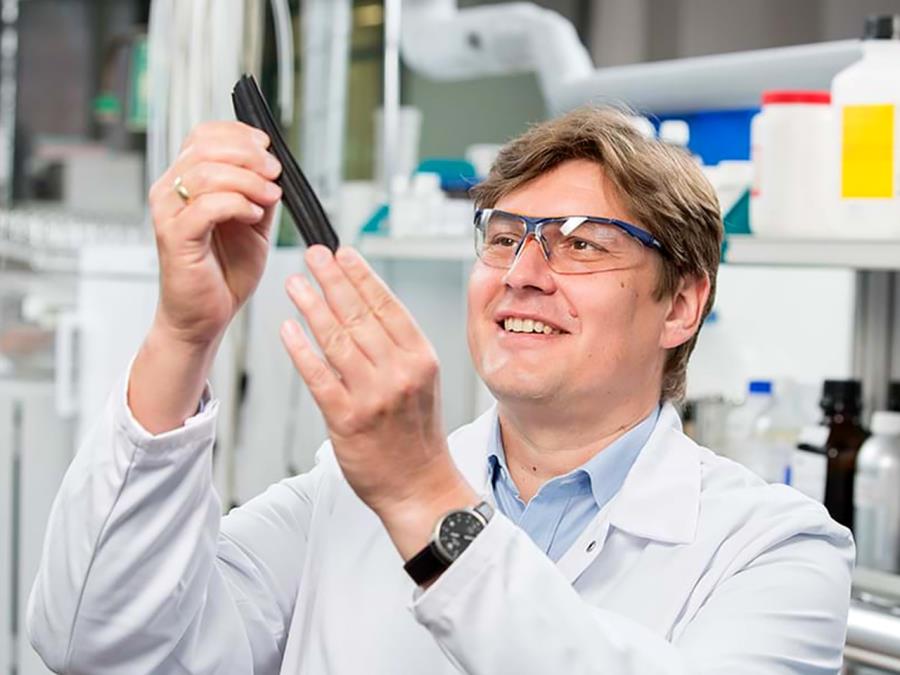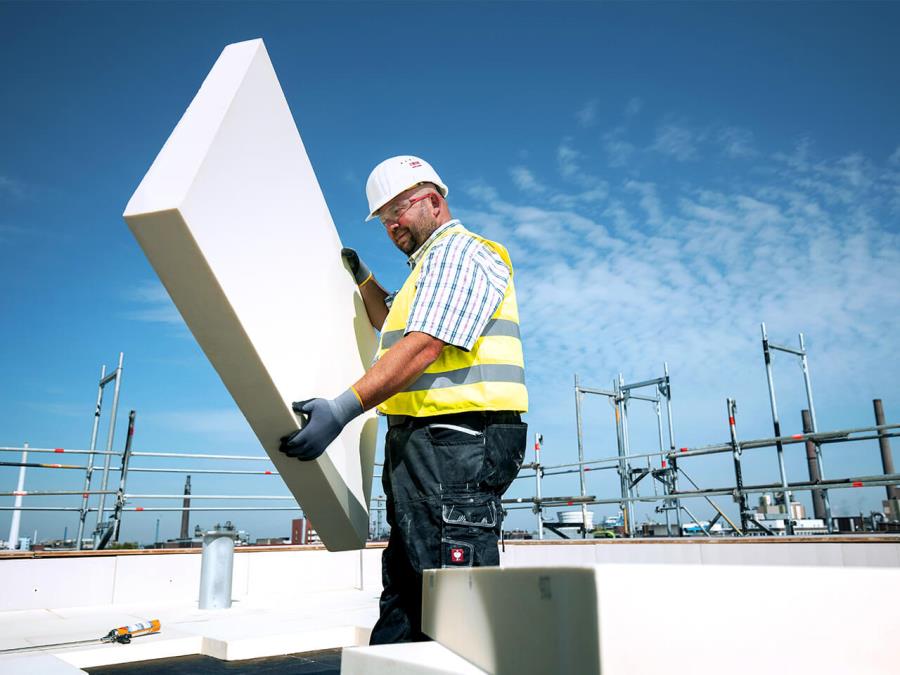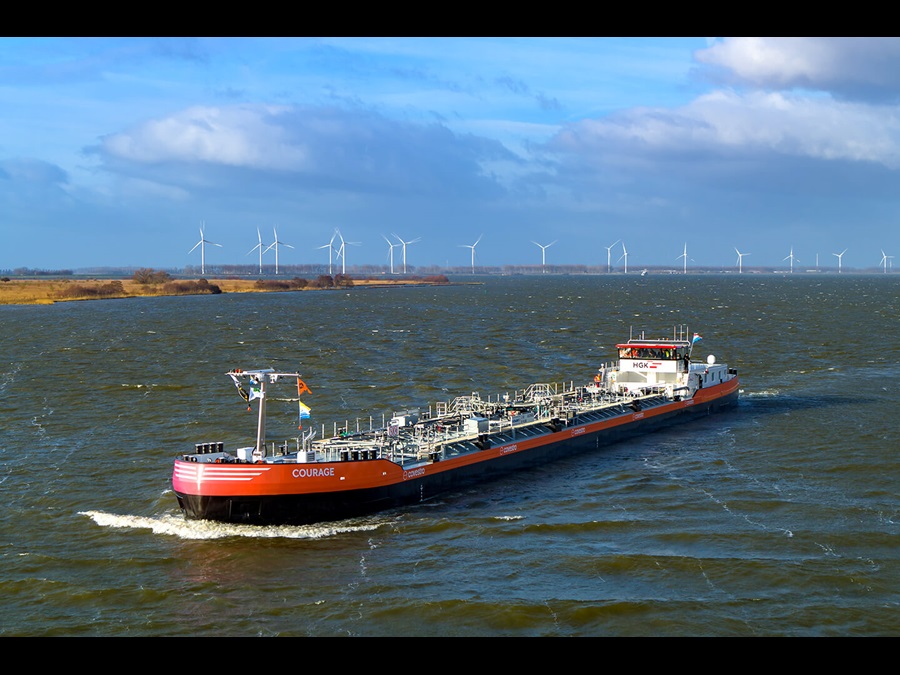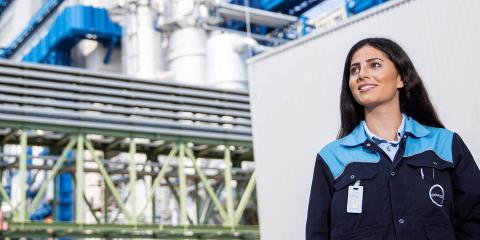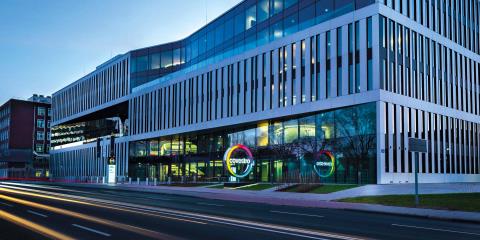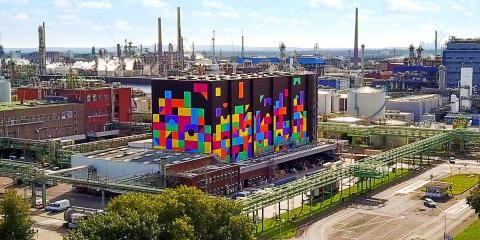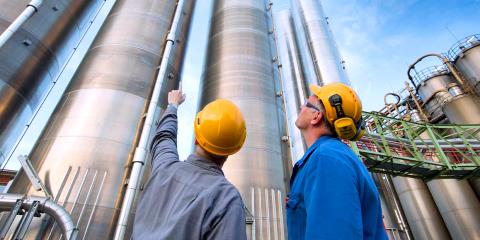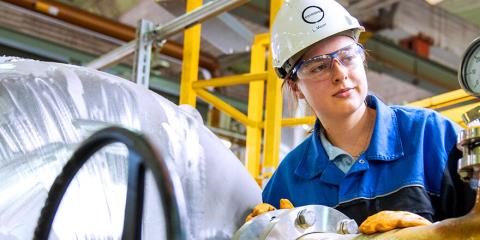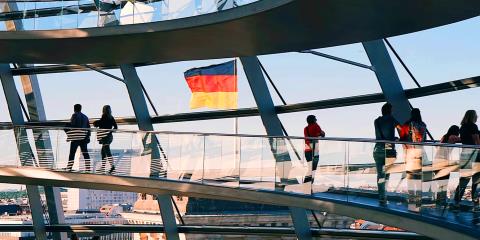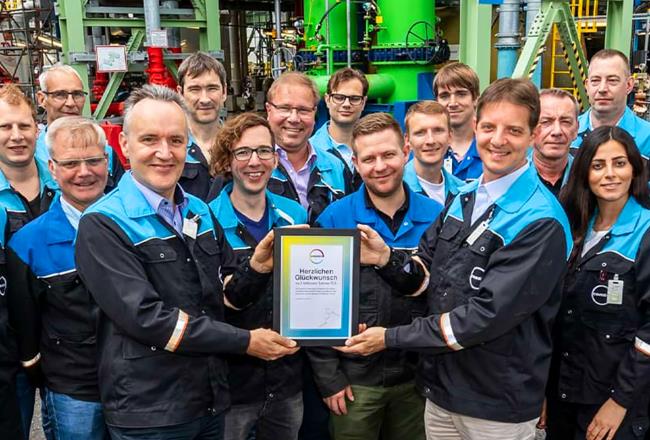
Raw materials network strengthens sites in North Rhine-Westphalia
The tight network ensures that the NRW sites, which employ around 6,450 people, are even more efficient. This is crucial, since almost 30 percent of Covestro's total global production capacity comes from Germany – a significant proportion of which from NRW. The sites in Leverkusen, Dormagen and Krefeld-Uerdingen currently still account for a significant proportion of the Group's greenhouse gas emissions. This should change as quickly as possible.
Covestro wants to be operationally climate-neutral by 2035. The aim is to achieve net-zero emissions from our own production (Scope 1) and from purchased energy (Scope 2) by then. Upstream and downstream greenhouse gas emissions in the value chain (Scope 3) are also to be significantly reduced by 2035 – in the long term, Covestro aims to achieve climate neutrality for Scope 3 emissions by 2050.
The company has therefore drawn up a clear roadmap for its NRW sites: The focus is on the use of 100 percent renewable electricity, the climate-neutral generation of steam and a significant increase in energy efficiency. In this way, growth and sustainability are to be linked even more closely in NRW.

1
employees
in NRW
(FTE)

1
young professionals
in NRW

1 Mio.
billion euros invested at the sites in North Rhine-Westphalia since 2015
The sites in North Rhine-Westphalia are managed by Dr. Philip Bahke, who is also the head of production in Dormagen. He is in constant contact with the two other production managers in North Rhine-Westphalia, Dr. Thorsten Rische (Leverkusen) and Dr. Rob Eek (Krefeld-Uerdingen). One of their main concerns is to make logistics processes leaner and to unify production processes. However, the reliable supply of the plants with raw materials, such as hydrogen, natural gas, carbon monoxide and nitrogen, and various forms of energy is also essential in order to compete internationally.
Verifiably sustainable production
Covestro has received the internationally recognized ISCC Plus mass balance certification for all three NRW sites. Customers can now be supplied with large product volumes from renewable attributed raw materials. These include, for example, selected polycarbonates, components for polyurethane (PU) rigid and flexible foams, PU coating and adhesive raw materials, thermoplastic polyurethanes (TPUs), and specialty films. Quality and properties are no different compared to their fossil-based counterparts. Covestro's certified mass-balanced products enable customers to achieve their own sustainability goals much faster. At the same time, they can also help to significantly advance the transition to a circular economy.
With its NRW site network, Covestro combines different corporate divisions such as maintenance, infrastructure, warehousing and service. As a result, the company is able to reduce costs for all of the NRW sites and improve their cost-competitiveness over the long-term. Thus, the network is key to achieving economic success in the region.
Award for sustainability strategy in NRW
Covestro was honored in the NRW – Economy in Transition competition for its sustainable products and processes. The expert jury honored the material manufacturer for its innovative entrepreneurial spirit. In particular, the panel recognized the company's exemplary alignment on the circular economy. Covestro is focusing on alternative raw materials, renewable energy, and lower emissions at its three NRW sites. The company also aims to develop innovative technologies to improve the recycling of end-of-life products and unavoidable waste. In this way, Covestro is successfully driving structural change in NRW.
Expanding infrastructure in NRW
To ensure that this remains the case in the future, Covestro needs intact infrastructure around its plants at its North Rhine-Westphalia sites. This is essential for the company's growth, work and well-being. Strengthening the overall transport system and creating a sustainable infrastructure in Germany is one of the pressing issues for Covestro. Traffic routes such as roads, railways and waterways need to be updated and better connected. Companies such as Covestro, after all, rely on the seamless and reliable supply and delivery of raw materials and products.
Improving the Rhine River as transport route for NRW sites
A well-developed infrastructure is essential to industrial companies in Germany. Covestro, for instance, procures approximately 75 percent of its goods in Leverkusen, Dormagen and Krefeld-Uerdingen via inland waterway transport. At the same time, the company ships out around 30 percent of its manufactured materials in NRW.
Consequently, Covestro has been strongly affected by the increasingly frequent low water in recent years. This is another reason why there is great interest in getting an even better handle on such extreme situations in the future.
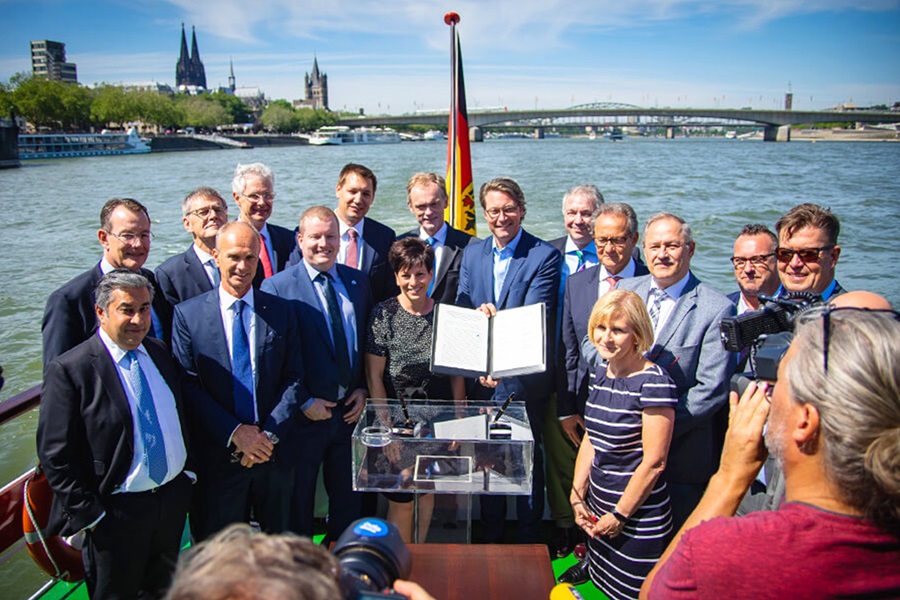
Despite changing climatic conditions, it is important that the Rhine remains a reliable transport route. Hence, the significance of inland waterway vessels as an efficient and environmentally friendly means of transport must be elevated. This might also be accomplished by developing new types of ships such as the flat-bottom vessels. Beyond that, water level prediction systems need to be improved. One barge replaces about 60 trucks or 25 rail tank cars.
Two new low-water vessels for Covestro
To build even more sustainable and reliable supply chains in the long term, Covestro has been using two new low-water ships on the Rhine since 2023. The "CURIOSITY" and the "COURAGE" now transport finished Covestro products from North Rhine-Westphalia to customers in an even more environmentally friendly way, while shining in bright Covestro colors.
Their diesel-electric drive allows CO₂ emissions to be reduced by up to 30 percent. Pollution from particulate matter and other pollutants can also be significantly reduced. In addition, both ships are already H₂- or future-fuel-ready and, thanks to their special design, can be converted to new types of propulsion systems such as hydrogen - as soon as they are ready for the market.
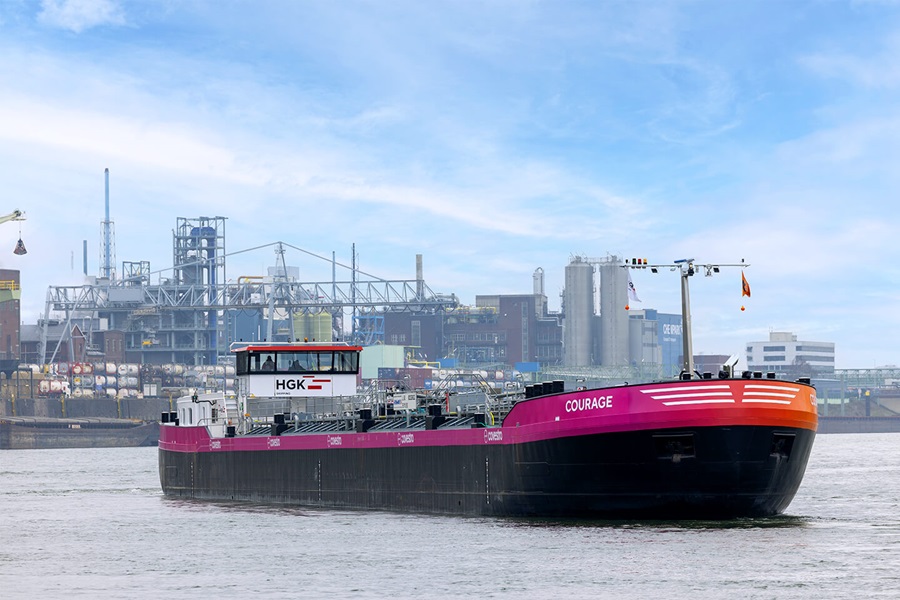
The special feature: Even at low water levels of up to 40 centimeters at the Cologne gauge, the low-water ships are ready for operation. The cargo can then be transported via the adjacent inland waterways to the Covestro site in Brunsbüttel.
Always on board: the Covestro values "COURAGE" and "CURIOSITY," which in the form of the ship's name are intended to ensure safe journeys.
Green electrolysis at NRW sites
On the path to operational climate neutrality by 2035, Covestro is also focusing on gradually converting its production to electricity from renewable sources. A particular focus is on the production of especially energy-intensive basic chemicals such as chlorine, caustic soda and hydrogen.
As part of a cooperation with LANXESS, the production of these chemicals can now be made even more climate-friendly. In the production of the chemicals that LANXESS purchases from Covestro, the materials manufacturer uses electricity with certificates of origin from hydropower on a pro rata basis in the electrolysis plants in NRW. This can reduce reported emissions by up to 120,000 metric tons of CO₂ per year.
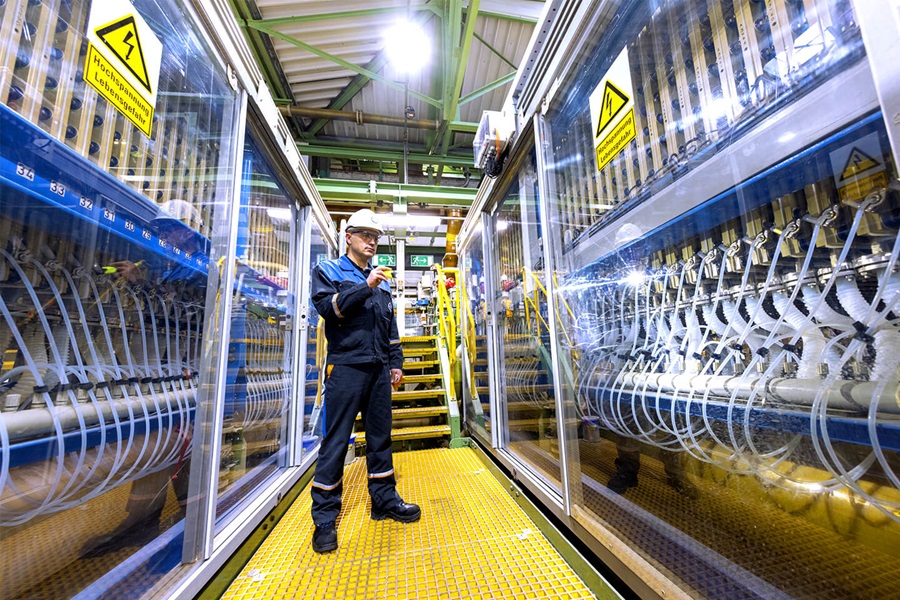
Chlorine, caustic soda and hydrogen are important basic components for many products in the chemical industry. The chemicals produced at the ISCC-Plus-certified Covestro sites in Leverkusen and Krefeld-Uerdingen are further processed at LANXESS to manufacture products for the food industry or agriculture.
Covestro wants to put CO pipeline into operation
From thermal insulation panels, to car headlights or smartphone housings – high-quality materials from Covestro are used in many different areas of everyday life. Carbon monoxide (CO) is an indispensable building block in the manufacturing process. However, the capacity at the site in Krefeld-Uerdingen is not sufficient in the long-term. The plants are therefore to be supplied with CO from the site in Dormagen via a supply pipeline. The pipeline with a length of 67 kilometres is almost finished, but is not yet in operation due to legal dispute and public requirements. The Higher Administrative Court (OVG) of Münster decided in late August 2020 that the planning approval for the construction and operation of the new pipeline is still effective.
The state parliament of North Rhine-Westphalia has repeatedly stated that the CO pipeline serves the public good. The law, which gave the project the green light, was supported by all parties and passed unanimously. The project strengthens North Rhine-Westphalia as an industrial location, making Krefeld-Uerdingen part of a reliable, safe, environmentally friendly CO infrastructure.
Covestro welcomes decision by the Higher Administrative Court of Münster
However, residents had complained about the project. They had failed a lawsuit against the district government of Düsseldorf, which approved and will later monitor the pipeline as the authoritative agency. Now, as of late August 2020, the court has found that the zoning approval for the construction and operation of the pipeline is legitimate. The Senate rejected the claim in its entirety as unfounded. This means that the zoning approval for the construction and operation of the supply pipeline is lawful.
The court clearly emphasized in a statement that the technical design of the pipeline and, therefore, its safety not only met the technical requirements in several respects, but went beyond them. “We believe our legal opinion has been confirmed” said Dr. Daniel Koch, Managing Director of Covestro’s facilities in North Rhine-Westphalia. The pipeline will go into operation as soon as the remaining legal and construction requirements are fully met. Covestro was involved in the proceedings as a joint party. Click here to read the full press release.
In August 2014, the Higher Administrative Court (OVG) of Münster suspended the proceedings for the planned carbon monoxide supply pipeline from Dormagen to Krefeld-Uerdingen and called upon the Federal Administrative Court (BVerfG) in Karlsruhe. The responsible chamber of the BVerfG decided unanimously, in a resolution of December 21, 2016, that the submission of the OVG should be rejected as inadmissible due to legal deficiencies. Furthermore, the Federal Constitutional Court made a clear statement that Covestro felt confirmed its position.
The judges in Karlsruhe stated that, in their view, the law on the supply pipeline is suitable to serve the public good and confirmed that the legal formulations were sufficiently well-founded. In addition, the BVerfG found that the statutory purposes of expropriation are sufficiently secured in the Pipeline Act itself.
In 2014 already, the OVG had stated that it had no fundamental reservations concerning the design of the pipeline in terms of safety and routing. Only with regard to the constitutionality of the Pipelines Act, on which the project is based on, the court saw further need for clarification. Hence the submission to the Federal Administrative Court in Karlsruhe, which was ruled inadmissible in 2016.
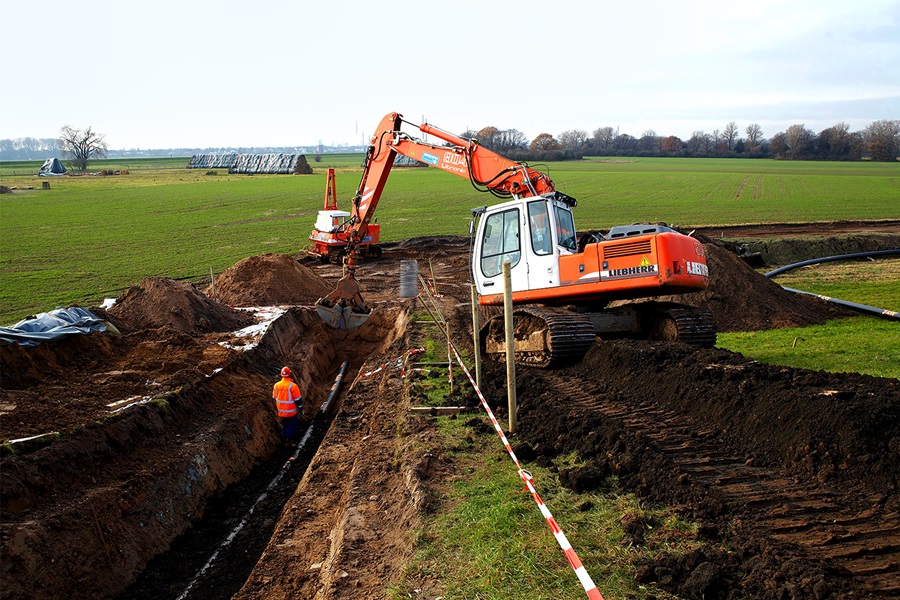
Comprehensive safety concept
The comprehensive safety concept for the new carbon monoxide pipeline exceeds legal requirements. It is operated at a maximum pressure of 13.5 bar. However, it was built to handle 100 bar, and tested at over 200 bar.
The plastic-coated steel pipes have a nominal diameter of 25 centimeters. The steel is high-strength, while remaining deformable. This protects the pipes against vibrations and earthquakes, among other impacts. The pipes are installed at a depth of at least 1.40 meters, although one meter is the legal requirement. The line is monitored twenty-four seven by an operation centre and regularly inspected by Technical Inspection Association (TÜV).
Immediate enforcement
In May 2020, Covestro filed a motion for immediate enforcement to complete the pipeline. The district government of Düsseldorf approved the motion, with an order for immediate enforcement. This order gives Covestro the opportunity to implement measures from the 2018 plan amendment decision, such as installing a second geogrid. These special grid is designed to protect the pipeline against damage. The order does not allow for preliminary commissioning.
Companies such as Covestro need planning security to carry out major projects. Germany faces fierce international competition. Covestro is convinced that it must be possible to construct and operate such safe pipelines in North Rhine-Westphalia, which is the industrial heart of Germany.
Questions and answers on the CO line
Why was the route located on the right bank of the Rhine?
No one likes foreign pipelines on their own territory – however, they cannot always be avoided. The best route was determined under the leadership of the district government, after considering all interests of the stakeholders involved. The route was based on existing infrastructure routes for railways and interstates. There are already a large number of pipelines in various routes on the right bank of the Rhine. This also generates synergy effects: the company WINGAS installed a natural gas pipeline along almost half of the entire route of the CO pipeline. Joint construction projects reduce environmental impact and require less space overall.
Are any residential areas affected?
The pipeline runs along existing infrastructure routes such as for railways and interstates whenever possible. However, this was not possible in all cases. Residential areas are also affected by the route of the pipeline. When the route was determined, property owners were approached personally (mid 2005). In addition, residents were informed with letters and brochures at the start of construction, and a website and phone hotline were established.
Why was the plan changed?
Plan amendments are usually unavoidable in complex infrastructure projects. In case of the CO pipeline, these changes came about after construction work had already started. The majority of the requested changes relate to route shifts of a few meters. Construction companies needed to change the location due to water, power, gas or oil pipelines they had found, or avoid other unexpected obstacles in the ground by adjusting the actual route of the CO pipeline. Ecological aspects such as protecting stands of trees, also led to changes. Despite evaluating all existing plans in advance, their exact location was not always known. It is common to combine such minor deviations in one subsequent application.
How safe is the CO pipeline?
Pipelines are the safest, most ecological means of transport for most liquid and gaseous substances. Carbon monoxide is transported safely via pipelines worldwide. Covestro used materials and concepts that go beyond existing safety standards when building the supply line. The walls of the plastic-coated steel pipes are particularly thick yet deformable. This protects the pipes in the event of vibrations and earthquakes. The pipes are installed at a depth of 1.40 meters, in some cases even significantly deeper. The legal requirement is just 1.00 meters. The pipeline is operated at a maximum pressure of 13.5 bar, but is designed for 100 bar.
How is the line monitored?
The continuous control is mainly based on the following systems: The pressure of the CO pipeline is continuously monitored - any irregularities would be detected immediately. Several leak detection and location systems are installed along the entire length of the pipeline. The smallest amounts of CO would be detected early with a sensor hose system by means of diffusion before a hazard could occur. In addition, the quantity of carbon monoxide is constantly controlled on both ends of the pipeline using the so-called model-based mass-balancing method. The same goes for the temperature and pressure in the pipeline. The pressure wave method supplements the mass balance method and is used for computer evaluation to locate the leakage point by means of the pressure wave curve. Further measuring equipment is installed – for instance, to determine the temperature and pressure in the pipeline route.
What is the contingency plan?
Although Covestro does not expect any irregularities in operating the CO pipeline, the company has taken extensive precautions to alert and protect residents in the event of a malfunction. Multiple independent safety systems will activate even in case of the slightest irregularities. If the monitoring equipment reports a deviation from the norm, the pipeline would be shut off immediately via several gate valves. It can be drained from both sides – toward Dormagen and toward Uerdingen. This ensures carbon dioxide can be disposed of safely, depressurizing the pipeline. A comprehensive emergency response plan will also go into effect.
Carbon monoxide – how dangerous is it?
Carbon monoxide (CO) is a toxic gas – it can be deadly, as it prevents the body from taking in sufficient oxygen. Carbon monoxide is subject to the Hazardous Substance Ordinance. However, CO is a gas that people live with every day in low concentrations: it is produced when we burn fuel in our vehicles and airplanes, or when we smoke cigarettes. Handling CO safely is crucial. Covestro has decades of experience in doing so, and carbon monoxide has been used at Covestro sites for years. Vast operational experience, employees specially trained in handling CO and highly sophisticated plant technology enables Covestro to ensure maximum safety.
Covestro – A good neighbor
Living together in harmony is very important to Covestro. This is why the company actively seeks out dialog and maintains close contacts with neighbors at its production sites. At Covestro, safety comes first. The company is dedicated to reducing risks for our employees and neighbors and to ensuring safe production processes. Additional information is available on the Chempark Krefeld-Uerdingen website.








